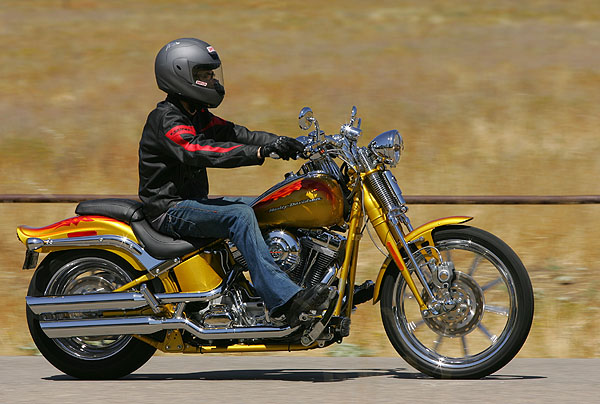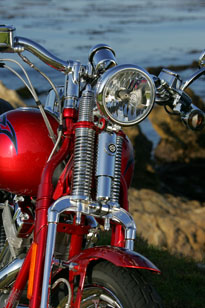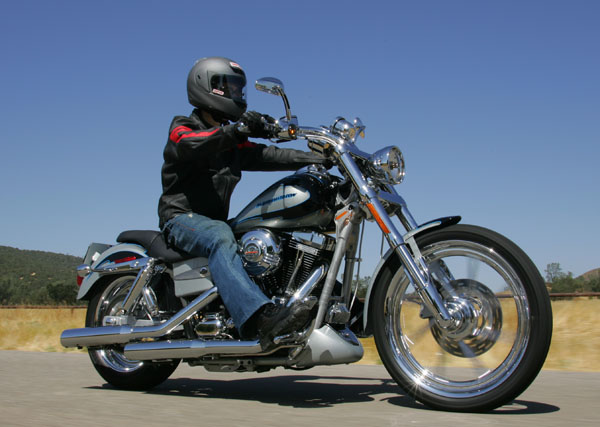
Screamin’ Eagle Softail Springer
The level of emphasis that Harley-Davidson places on its accessories, which are sold through every H-D dealership, is unique among major OEMs. In recent years many other manufacturers have attempted to emulate the American company’s success in the accessories market by increasing the depth and breadth of their own accessory lines. Still, no other manufacturer can rival H-D’s 863 page accessory catalog, which lists hundreds of parts for each of the company’s model lines.
In the interest of promoting its existing accessories, as well as developing new parts for their most recent models, each year H-D’s Custom Vehicle Operations (CVO) division designs a few special ‘customs’, fully tricked out with parts from the H-D Accessories catalog, and sold in limited numbers through certain dealers.
More important than their sales (the small number of CVO bikes sold barely impacts in H-D’s yearly sales figures) is that the CVO bikes act as a roadmap for owners of their more ordinary cousins, showing them how far they could possibly take their standard Softails or Dynas using only Genuine Harley-Davidson accessories. The CVO bikes are also a flashy platform to show off the latest accessories, which are often developed in conjunction with the CVO bikes themselves – usually when the CVO designers can’t find anything in the existing accessory lineup that would fit with their vision.

For 2007, CVO premiered an entirely fresh lineup of modified Harleys, all based on the standard 2007 models which feature the redesigned Twin Cam 96 motor and six-speed Cruise Drive transmission (which I reviewed last month). However, all four CVO models (Softail, Dyna, Road King, and Electra Glide) feature an all-new bored-out version of the Twin Cam 96, designated the Twin Cam 110. The TC110 displaces 110ci (1800cc) and is now available as an upgrade for all TC96-powered 2007 H-D models. If installed as a kit by a certified H-D dealership, the TC110 upgrade retains the smog legality of the TC96 bikes, even in California.
Producing 103 ft-lbs of torque (Harley doesn’t quote HP numbers for its ‘Big Twin’ models), the TC110 motor is quite aggressive, even compared to the already strong TC96 motor. Paired up with the carefully chosen ratios of the new six-speed transmission, the CVO bikes accelerate with authority in any gear. The flat, torquey power curve is, at least in my opinion, ideal for a cruiser – minimizing the importance of gear selection and maximizing the availability of roll-on power. Although the design of the exhaust system varies by model, all the CVO machines also issue an aggressive bark that will definitely turn the heads of passing pedestrians, and even the occupants of nearby cars.
At the 2007 Harley-Davidson CVO introduction in San Luis Obispo, California, I had a chance to spend a little time on board each of the new CVO machines. Unfortunately, when I say ‘a little time’, I mean it – trying to test four completely different bikes in only one day of riding doesn’t give much time to form a solid impression of any of them. For this reason, the riding impression section of this ‘First Ride’ article (and the second part, which will follow tomorrow) will be severely truncated compared to our usual depth. However, since I doubt many of our readers will actually be buying a CVO H-D (the severely limited production numbers mean that most will already be sold by the time you read this), content yourself with looking at the pictures and drawing inspiration on how to customize your own standard H-D with the same parts found on these bikes (all of which are available through the H-D parts and accessories catalog).

Based on the popular Softail Springer model, the Screamin’ Eagle Softail Springer is certainly the most eye-catching of the four 2007 CVO models. The contrast between the chromed and color-matched portions of the ‘springer’ fork (see photo) really emphasizes the mechanical simpilicity of this classic suspension design. As with all the CVO models, the quality of finish (paint and powdercoating) is beyond impressive, to the point where it is impossible to truly do justice in photos (even those, like the shots in this article, taken by the extremely talented Kevin Wing). The high-quality paint and powdercoating contrasts with a healthy slathering of chrome (common to all CVO models) and the attractive Revolver wheels (wrapped with a wide, but not too wide, 200mm tire out back) to give the CVO Springer a serious custom look. The details bear this out, from the beautiful integrated gauges and hidden fuel gauge (you’d have to see it to appreciate its trickness) to the sweet smoked LED taillight and chromed ‘Centerline Collection’ forward foot controls.
The ride is similar to that of a standard Softail, although the stepped seat design (from the H-D accessory catalog, natch) is much more comfortable than the standard unit, and the reach to the forward foot controls is rather long, even for the average-height (5’9″) author. Unfortunately, the forward controls touch down early when cornering, unsurprising considering that the CVO Springer loses .5″ of ground clearance when compared to the standard Softail Springer. Ah, the price we pay for looking cool, I suppose.
The TC110 motor is the highlight of a ride on the Springer, with its loping rumble and stomping torque constantly tempting the rider to a quick snap of the throttle. Like the stock H-Ds I rode last month, throttle response is immaculate, with not even a hint of jerkyness or stutter when transitioning from closed to open throttle. The refinement can come as a surprise, considering the exhaust note, which brings to mind the rough and tumble idle of a Chevy small-block with a big cam.

Screamin’ Eagle Dyna
Next up is the Screamin’ Eagle Dyna, which in its “Silver Rush and Midnight Black” paint scheme is much more low-key, but just as beautiful (if not more so) than the flashy Springer. As with the Springer, the paint is amazing, and the details hold your attention, giving credence to its title of ‘custom’. The Dyna is also a slightly better companion than the Springer on a twisty road, although in the end its cornering ability is still limited by a distinct lack of ground clearance. The forward-mount foot controls are still a long way off, but the bucketed seat is even more comfortable than the one on the Springer.
My only complaint about the Dyna was the shiny billet grips, which seem to have been designed to be gripped bare-handed – the palms of my gloves couldn’t seem to get any purchase on the smooth surface. They may look cool when the bike is parked, but wouldn’t it be embarassing to hit a bump on a back road and crash in front of all your buddies, merely because your hands slipped off your shiny grips? Give me some rubber or leather, please!
The 2007 Screamin’ Eagle Softail Springer and the 2007 Screamin’ Eagle Dyna both retail for $24,995 in the US ($25,095 in CA), and only 2,500 of these special Springers and 2,400 Dynas will be produced. Check the Harley-Davidson web site for more info. Check back with MD tomorrow to see Part 2 of our 2007 CVO review, where we tell you about CVO’s take on the H-D Road King and Electra Glide.





